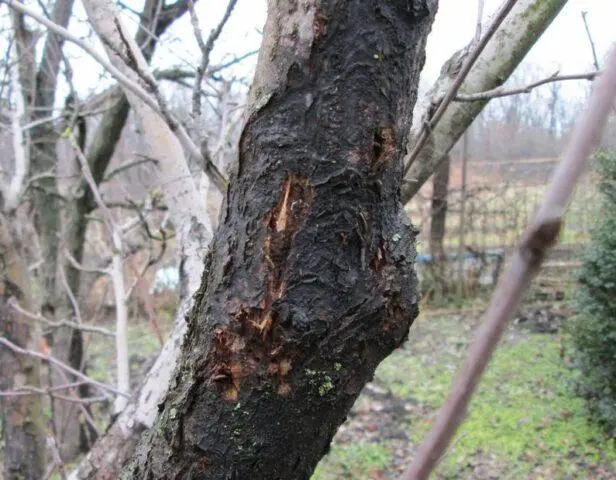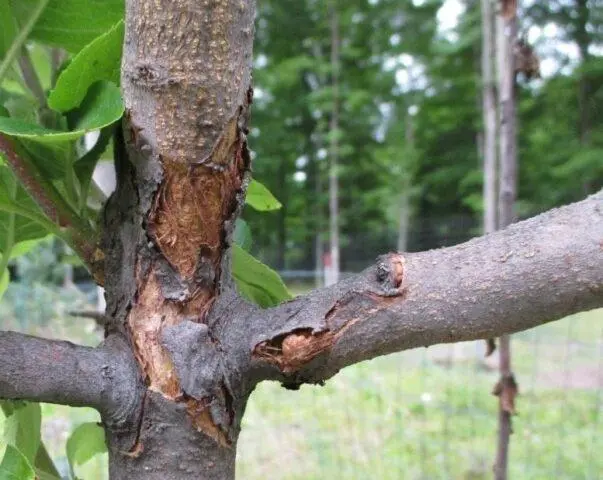Contents
If the branches of the apple tree turn black, this indicates the appearance of black cancer. The disease is caused by fungi, which can lead to irreversible consequences, including the death of the tree. Therefore, treatment is started as early as possible. All affected parts of the black bark are cleaned with a wooden scraper, after which they proceed to fungicide treatment. For these purposes, copper or iron sulphate is used. Then they coat the wounds with garden pitch and leave to dry.
Why does the trunk and branches of the apple tree turn black
Blackness on the trunk of an apple tree indicates the development of black cancer (it is often also called “Antonov’s fire”). Pathology can affect any part of the tree, but it carries a special danger for the trunk. If the trunk is affected, such a plant can be helped only at the initial stage. Very often, a tree has to be cut down, since treatment is no longer possible or extremely problematic and costly.
The causative agent of the disease is a dangerous marsupial fungus, which belongs to the Botrisferiaceae family. It penetrates through damage to the bark, which occurs due to age-related causes, as well as due to adverse weather conditions and improper care.
The reasons for the appearance of black spots on the bark of an apple tree can be different, the most common are:
- Rare top dressing, unbalanced fertilizers.
- Irregular watering. This factor negatively affects after a bountiful harvest, when the tree is depleted and requires special care.
- Sunburns and frost cracks lead to flaking of the bark, and it is in these places that infection can penetrate. If the bole is not whitewashed, it gets very hot, which can lead to peeling of the surface layer.
- Sharp temperature changes lead to similar consequences. For example, if during the day it was hot up to +30 ° C, and at night the temperature dropped to 8-10 degrees, the bark may also crack.
- Too late spring or early autumn pruning, when dangerous fungi can penetrate into the resulting wounds.
With age, trees weaken, poorly resist diseases, infections and adverse weather conditions.

The main cause of black cancer is pathogenic fungi that penetrate through the bark of a tree.
Blackness at the core
If not only the surface turns black, but also the core of the branch, trunk, this is the most dangerous phenomenon. The disease is already running, and there is little chance of recovery. But you can try to cure even such an apple tree. The dead part is excised, slightly capturing healthy tissue. Then they are treated with a powerful fungicide.
Blackened trunk of an apple tree from below
If a young or old apple tree has a blackened trunk in the lower part, this also indicates the development of black cancer. Treatment must be radical. The affected part should be cut out and processed. Next, a bridge is grafted in order to save the upper part (crown). But if the defeat is severe, this method is ineffective.
Black bark on an apple tree
Black bark on apple tree branches is a less dangerous option. If the cancer has affected only the surface layers, it is quite possible to cope with it. The method of treatment is the same – the affected part is cleaned off, after which it is treated with a solution of copper sulfate or another strong fungicide.
The main signs of the disease
Cancer infection can be determined not only by black spots on the bark of the trunk, branches, but also by a number of other signs:
- Spots on the leaves – they appear in early spring, literally immediately after blooming. Moreover, the spots are dark, with a purple color, rounded. Appear only on the outer side of the leaf plate. Gradually increase in size and turn brown, while the edges remain purple. Then rings and black formations are formed on them – pycnidia. This is the name of the fruiting body of the fungus, which is the source of the disease.
- Further, the foliage dies off rather quickly and falls off ahead of time. The apple tree may lose a significant part of the leaves in June-July. This is bad for productivity. Part of the ovaries will fall off, few fruits are formed.
- Brownish spots appear massively on apples. At first they are small, then they increase in size, covering almost the entire surface. Black pycnidia appear on the fruits, which go in the form of circles.
- Some of the apples are mummified, harden, while they hang even in autumn after leaf fall. They acquire a pure black color, like bark (without a blue tint). They may also be brown. The surface is rough.

The trunk of an apple tree affected by black cancer can be identified visually
Features of the blackening of the trunk of an apple tree
The symptoms of the disease are the same – the bark of the apple tree turns black, and in advanced cases, the underlying, deep plant tissues also suffer. In many cases, additional symptoms may be added to the standard symptoms. For example, the bark of an apple tree may become wet or, conversely, dry out. Often black spots or white growths appear on the surface.
Drying up
Since the fungus that causes black cancer parasitizes the apple tree, this can lead to drying out of the surface of the bark. Especially often this phenomenon is observed in drought, as well as with insufficient watering. Treatment is standard – cut out the affected areas, process and treat with garden pitch or a mixture of clay and manure (1: 1).
The occurrence of wet areas
If the affected black areas of the bark become wet, this indicates the development of putrefactive bacteria that decompose dead wood. Treatment also involves stripping and processing with copper sulphate. This drug well destroys not only fungi that provoke black cancer, but also colonies of bacteria.
Appearance of white patches
White growths indicate the origin of the mycelium of tinder fungi. They only grow on dead trees because they cannot feed on healthy living tissue. Therefore, the appearance of a tinder fungus in itself indicates an advanced stage of the disease. You can try to clean it from the black bark and process it. But cure is not always possible.
bark cracking
Cracking of the bark is one of the characteristic symptoms of cancer not only of apple trees, but also of other fruit trees (pear, apricot, peaches). In this case, all affected areas are cleaned to healthy areas, after which they are treated with copper sulphate and garden pitch. But if the trunk is affected by more than 50% black spots, the tree will have to be uprooted and burned.
Appearance of black spots
If black spots appear on the trunk, they should be removed as soon as possible. They clean and disinfect with copper or iron sulphate. Otherwise, black spots will quickly turn into cracks and deep wounds. It remains to cut such branches to a healthy place, and sprinkle the slices with crushed charcoal powder.

The first step is to thoroughly clean
What to do if branches and trunk turn black on an apple tree
No matter where exactly the bark has become black, the treatment looks the same:
- First you need to clean the affected areas. To do this, use a wooden scraper, since metal objects will not work. Stripping is done to a healthy part of the bark or wood with a small grip to insure against the possible spread of infection.
- The diseased bark is removed with a grip of 1-2 cm, branches – by 10-15 cm. In the case of a trunk, it is also desirable to remove it with a large margin of up to 15 cm.
- Carry out treatment with a solution of copper or iron sulphate of a sufficiently high concentration of 3-5%. Other fungicides are less effective because not all drugs act simultaneously on fungi and bacteria.
- Cover the sections where the black bark used to be. To do this, use garden pitch (you can buy it or make it yourself) or a mixture of clay and manure in equal amounts. You can take the usual clay talker.
Along with vitriol, gardeners recommend using the Vitaros contact system fungicide. It contains two active ingredients at once – carboxyl and thiram. It acts sparingly on the apple tree, without burning plant tissues. Consumption rate – 20 ml per 10 liters. The resulting solution is used to treat areas where there used to be black bark and healthy trees.
Another suitable remedy is the Strobi fungicide. It contains kresoxim-methyl. The drug has a universal action, it copes well with most fungal diseases. It inhibits the growth of mycelium, inhibits the formation of spores. Effective even when used in cool weather (1-5 degrees Celsius). Consumption rate – 2 g per 10 liters.

Damaged places are treated with garden pitch
Preventive measures
Black cancer is a dangerous disease that, in its advanced stages, cannot be treated and leads to the death of even young apple trees. To prevent such consequences, it is very important to follow basic preventive measures. Experienced gardeners recommend the following rules:
- Even if the garden is healthy, the bark must be inspected regularly, which is especially true for old apple trees. When black spots appear, it is imperative to carry out total stripping and treatment with fungicides.
- Sanitary pruning is planned every spring – dry, old, dried up and obviously diseased branches are removed. If necessary, this can be done even during the season.
- Choose varieties of apple trees that are adapted to growing in a particular region. It must be frost-resistant and drought-resistant varieties.
- It is necessary to observe the timing of pruning, spending it in cool weather (up to 5-7 degrees Celsius). In this case, you should always treat the blades of tools with a weak solution of potassium permanganate, and sprinkle wounds with crushed charcoal or lubricate with garden pitch.
- Observe the watering rate and do not overfeed with nitrogen fertilizers. This leads to cracking of the cortex, as a result, through the resulting wounds, the infection quickly penetrates into the deeper layers of tissues.
- Pest control every spring. In the summer, if necessary, use chemical or folk remedies. Many insects carry spores of dangerous fungi, so it is important to deal with pests in a timely manner.
- Regularly whitewash the trunk to a height of at least 30 cm from ground level.
Conclusion
When branches turn black on an apple tree, this is the main sign of the development of black cancer. The pathology is infectious, but practically does not threaten healthy trees, since the pest penetrates through the damaged bark. To prevent black cancer, it is recommended to regularly prune, inspect trees, and ensure normal watering and care.









